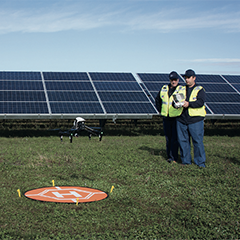There are a variety of field service applications across industries involved with power and energy solutions. The constant desire for efficiency motivates industry leaders to evaluate which technological advancements provide opportunities to optimize.
Be it enterprise-level, commercial or utility-scale, field service plays a vital role for maintenance and repair. The availability of technology enriches performance and operations in various ways.
Through innovation and self-solve tools, customers can cut costs and handle some maintenance by leveraging manufacturer supplied resources catered to their own industry and expertise.
Here are three ways we see tech innovation impacting the PV field service industry.
Automated Monitoring and Analysis
SMA uses an automated data analysis program to remotely monitor, troubleshoot and even replace faulty inverters and inverter components. SMA Smart Connected leverages the data supplied by Sunny Portal, the world’s largest PV monitoring repository, to receive inverter information and offer proactive service.
This technology allows the field service team to identify the correct fault diagnosis without a diagnostic trip. This can reduce service trips by 50%, resulting in significant time and cost savings. Automated monitoring and analysis also allow a new device to be shipped before an on-site technician is even aware of the issues, further reducing the administrative management needed for service repairs
or replacements.
Installers can leverage the program to target customer service solutions specific to the site, saving time, conserving analysis costs, and minimizing system downtime. The result of this innovation is peace of mind for the customer and more efficient, and less costly service operations for the installer.
In addition to Smart Connected automation, SMA also offers two Solar Monitoring Centers (SMC), one in California and one in Germany These innovative hubs provide a watchful, proactive eye on commercial and utility solar investments. Through continuous, real-time remote monitoring capabilities, the SMC ensures systems continue to perform as expected. This keeps revenue growth on track by maximizing performance and minimizing downtime. The SMC technology analyzes performance to ensure maximum inverter power generation. If there are problems that arise, they are identified in real-time via a notification. This process assesses the need for a truck roll, creates a ticket and dispatches field service engineers to resolve issues quickly.
Aerial Thermography
Drones are used across many industries and are becoming popular for field service. Drones and aerial thermography are transforming commercial, utility and storage installation service. Within solar field service, historically, technicians had to manually review sites for hot spots in a PV array. Drones have the capacity to fly over projects and take thermal readings from above.
This type of technology is now utilized to maintain optimal array performance. A properly maintained solar system can increase yields by as much as 30 percent and accelerate return on investment. With aerial thermography, maintenance can be more accurate, faster, and cost-effective than in the past.
SMA has FFA-certified experts working with the field service team to make aerial thermography available through plantwide operations and maintenance services. Using drones, issues can be detected down to the cell level. This technology is critical as the identification of these hot spots can indicate more problems or future issues in process. When aerial thermography is utilized, time is saved with diagnosis and challenges are addressed quickly so customers can keep their systems running at maximum output.



























